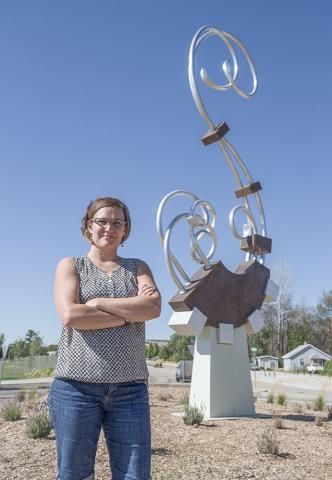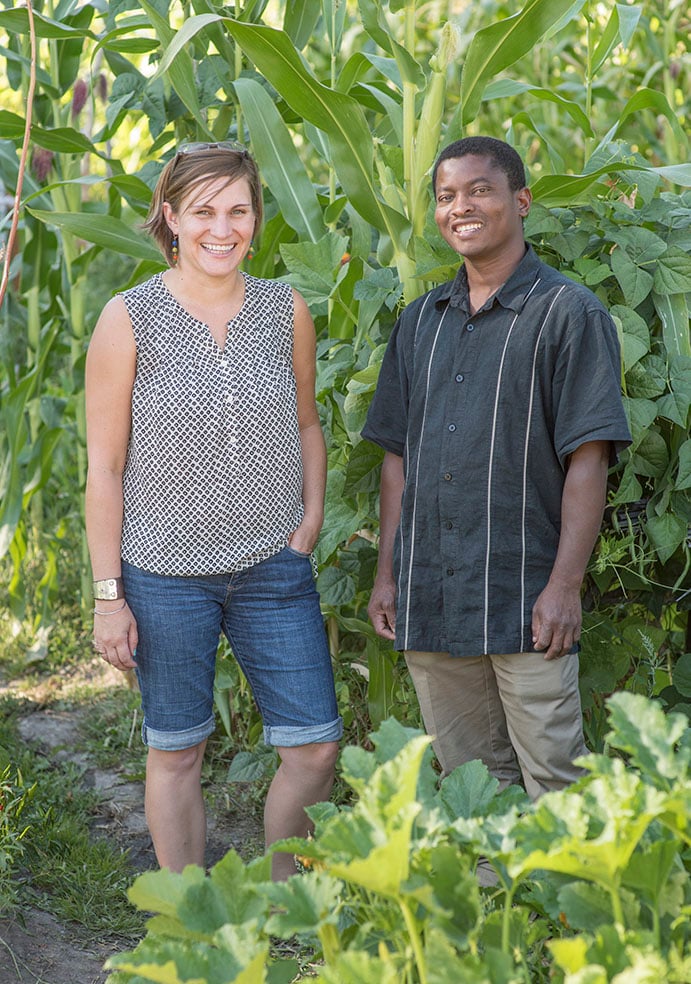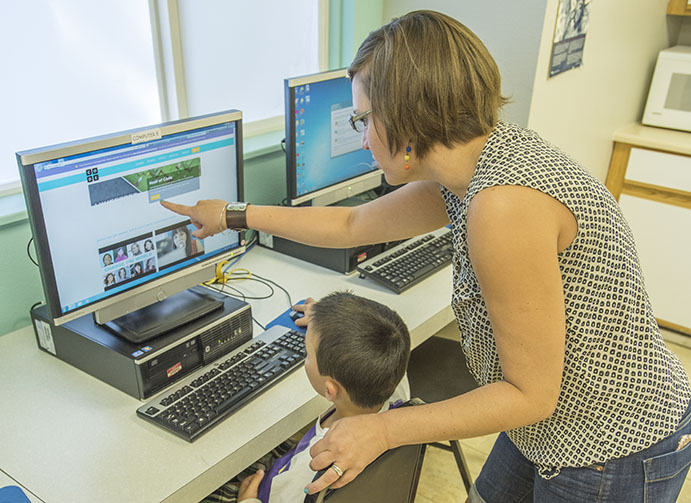Image

When Erin Sorensen and her husband moved into the Veterans Park neighborhood of Boise, Idaho, it was so “rough” he wondered why she was insistent it was a good choice. A few homes were clearly a hive of drug-related activity, police came in and out, fences were vandalized with spray paint and the school bus was a shooting target.
“We were first-time homebuyers and we needed some place affordable,” she recalls, adding that Veterans Park is the neighborhood where her father grew up. “But I could see it had the right ‘bones’: the downtown district was just a skateboard’s distance away—perfect for commuting—and a beautiful river was so close. I could tell it was up-and-coming, and would eventually be a place where my family would be glad to stay.”
A little more than 10 years later, Erin is (among many accomplishments) the former board president for the Veterans Park Neighborhood Assn. (and current member), chair of the NeighborWorks Boise board real estate committee and a member of the local chamber’s Leadership Boise initiative. Veterans Park has improved so much that the current challenge is to avoid the negative effects of gentrification, thus pricing her family and others out of their beloved neighborhood.
How did such a change happen? Sorensen is widely recognized as one of the reasons.
Sorensen recalls first getting seriously involved in her neighborhood in late 2007, when there was talk of an extension of 30th Street that would have separated the homes from the river (fortunately, it was delayed until a master plan was completed). Instrumental in recruiting Erin into the local neighborhood association was Shirley Randolph, a 1995 winner of NeighborWorks America’s Dorothy Richardson Resident Leadership Award. (That same “fiery grandmother” also introduced Erin to NeighborWorks Boise, leading her to join the board of directors as a residents’ representative.)
Sorensen’s first major project was the conversion of a vacant lot near her home into a community garden. The initiative was a collaboration with Global Gardens, a program of the Idaho Office for Refugees that focuses on healthy lifestyles and entrepreneurial training through the cultivation, harvest, cooking, eating and sales of fresh produce. Looking to recruit the first participants in the garden, Erin and two other women went door to door through the NeighborWorks’ apartments across the street, home to many migrants and refugees from countries such as Somalia and Nepal.
“I’d lived there since 2005, but I didn’t know much about the residents,” confesses Sorensen. “I just knew they were a little ‘different’ and didn’t speak English as well as me. It was a really formative experience, getting to know them for the first time.”
 That was in 2009. Today, 15 families are working plots in the Jordan Street Garden, along with a group of mostly mothers and children who cultivate a common plot. Tuesday nights in the garden have become a social event in the community. In addition, about 10 more families are developing a private lot along with another nonprofit called Deep Roots Boise, formed by a local resident to support communities and land owners as they convert empty plots into community gardens.
That was in 2009. Today, 15 families are working plots in the Jordan Street Garden, along with a group of mostly mothers and children who cultivate a common plot. Tuesday nights in the garden have become a social event in the community. In addition, about 10 more families are developing a private lot along with another nonprofit called Deep Roots Boise, formed by a local resident to support communities and land owners as they convert empty plots into community gardens.
Sorensen didn’t stop there, however. Wondering why her neighborhood was such a target for petty crime, Sorensen began noticing the groups of mostly 12- to 14-year-old boys hanging around on the street corners, and got to know most of them by name.
“They were bored,” she says. “When my father was a boy, he would go down by the river and shoot a BB gun, but that’s not considered appropriate or safe here anymore. And there wasn’t any other ‘infrastructure’ for kids, like a basketball hoop or soccer field.”
Then Sorensen learned about the community room at the Davis Park Apartments, the same NeighborWorks property she had canvassed for the garden. The Boise Parks and Recreation Department had had to cut its after-school and summer program there, and it was available. She seized the opportunity. The first step was simply to open the room for a few hours each Saturday and turn on the facility’s four computers—with Erin as the “facilitator.” From there, the activity expanded to include interactive games and toys to help younger children develop fine motor skills. Once NeighborWorks’ AmeriCorps Vista workers joined in and secured some grant funding, a formal Explorer program was added to build youths’ STEM (science, technology, engineering and math) skills.

“I wanted to bring more opportunities to the neighborhood, so the young people would feel like they belonged and were valued,” explains Sorensen. “It didn’t take long to attract them. They would see all the activity in the community room and stick their heads in, saying, ‘what’s going on?’”
Sorensen brought that same instinct for “drawing people in” to her work on a team charged with developing the 30th Street master plan. Her focus was an infusion of the area with a celebration of culture, resulting in the identification of 16 opportunities for public art—of which three have been realized to date.
“I see art as an opportunity for creative placemaking,” she explains, adding that most lower-income neighborhoods aren’t given the opportunity for art investments. “People could never seem to remember our neighborhood or where we are located, but now, they see a sculpture that makes them go, ‘whoa!’—in a good way.”
Today, Sorensen is spending most of her time working with NeighborWorks Boise on the challenges of preserving affordable housing. “Land values are skyrocketing and I don’t want teachers, firefighters [like her husband] and other working-class residents to be priced out of our own neighborhood. I want to make sure it continues to offer a place for us to call home.
Failed to load widget object.
Object reference not set to an instance of an object.
Object reference not set to an instance of an object.
“We were first-time homebuyers and we needed some place affordable,” she recalls, adding that Veterans Park is the neighborhood where her father grew up. “But I could see it had the right ‘bones’: the downtown district was just a skateboard’s distance away—perfect for commuting—and a beautiful river was so close. I could tell it was up-and-coming, and would eventually be a place where my family would be glad to stay.”
A little more than 10 years later, Erin is (among many accomplishments) the former board president for the Veterans Park Neighborhood Assn. (and current member), chair of the NeighborWorks Boise board real estate committee and a member of the local chamber’s Leadership Boise initiative. Veterans Park has improved so much that the current challenge is to avoid the negative effects of gentrification, thus pricing her family and others out of their beloved neighborhood.
How did such a change happen? Sorensen is widely recognized as one of the reasons.
Sorensen recalls first getting seriously involved in her neighborhood in late 2007, when there was talk of an extension of 30th Street that would have separated the homes from the river (fortunately, it was delayed until a master plan was completed). Instrumental in recruiting Erin into the local neighborhood association was Shirley Randolph, a 1995 winner of NeighborWorks America’s Dorothy Richardson Resident Leadership Award. (That same “fiery grandmother” also introduced Erin to NeighborWorks Boise, leading her to join the board of directors as a residents’ representative.)
Sorensen’s first major project was the conversion of a vacant lot near her home into a community garden. The initiative was a collaboration with Global Gardens, a program of the Idaho Office for Refugees that focuses on healthy lifestyles and entrepreneurial training through the cultivation, harvest, cooking, eating and sales of fresh produce. Looking to recruit the first participants in the garden, Erin and two other women went door to door through the NeighborWorks’ apartments across the street, home to many migrants and refugees from countries such as Somalia and Nepal.
“I’d lived there since 2005, but I didn’t know much about the residents,” confesses Sorensen. “I just knew they were a little ‘different’ and didn’t speak English as well as me. It was a really formative experience, getting to know them for the first time.”
 That was in 2009. Today, 15 families are working plots in the Jordan Street Garden, along with a group of mostly mothers and children who cultivate a common plot. Tuesday nights in the garden have become a social event in the community. In addition, about 10 more families are developing a private lot along with another nonprofit called Deep Roots Boise, formed by a local resident to support communities and land owners as they convert empty plots into community gardens.
That was in 2009. Today, 15 families are working plots in the Jordan Street Garden, along with a group of mostly mothers and children who cultivate a common plot. Tuesday nights in the garden have become a social event in the community. In addition, about 10 more families are developing a private lot along with another nonprofit called Deep Roots Boise, formed by a local resident to support communities and land owners as they convert empty plots into community gardens.Sorensen didn’t stop there, however. Wondering why her neighborhood was such a target for petty crime, Sorensen began noticing the groups of mostly 12- to 14-year-old boys hanging around on the street corners, and got to know most of them by name.
“They were bored,” she says. “When my father was a boy, he would go down by the river and shoot a BB gun, but that’s not considered appropriate or safe here anymore. And there wasn’t any other ‘infrastructure’ for kids, like a basketball hoop or soccer field.”
Then Sorensen learned about the community room at the Davis Park Apartments, the same NeighborWorks property she had canvassed for the garden. The Boise Parks and Recreation Department had had to cut its after-school and summer program there, and it was available. She seized the opportunity. The first step was simply to open the room for a few hours each Saturday and turn on the facility’s four computers—with Erin as the “facilitator.” From there, the activity expanded to include interactive games and toys to help younger children develop fine motor skills. Once NeighborWorks’ AmeriCorps Vista workers joined in and secured some grant funding, a formal Explorer program was added to build youths’ STEM (science, technology, engineering and math) skills.

“I wanted to bring more opportunities to the neighborhood, so the young people would feel like they belonged and were valued,” explains Sorensen. “It didn’t take long to attract them. They would see all the activity in the community room and stick their heads in, saying, ‘what’s going on?’”
Sorensen brought that same instinct for “drawing people in” to her work on a team charged with developing the 30th Street master plan. Her focus was an infusion of the area with a celebration of culture, resulting in the identification of 16 opportunities for public art—of which three have been realized to date.
“I see art as an opportunity for creative placemaking,” she explains, adding that most lower-income neighborhoods aren’t given the opportunity for art investments. “People could never seem to remember our neighborhood or where we are located, but now, they see a sculpture that makes them go, ‘whoa!’—in a good way.”
Today, Sorensen is spending most of her time working with NeighborWorks Boise on the challenges of preserving affordable housing. “Land values are skyrocketing and I don’t want teachers, firefighters [like her husband] and other working-class residents to be priced out of our own neighborhood. I want to make sure it continues to offer a place for us to call home.

